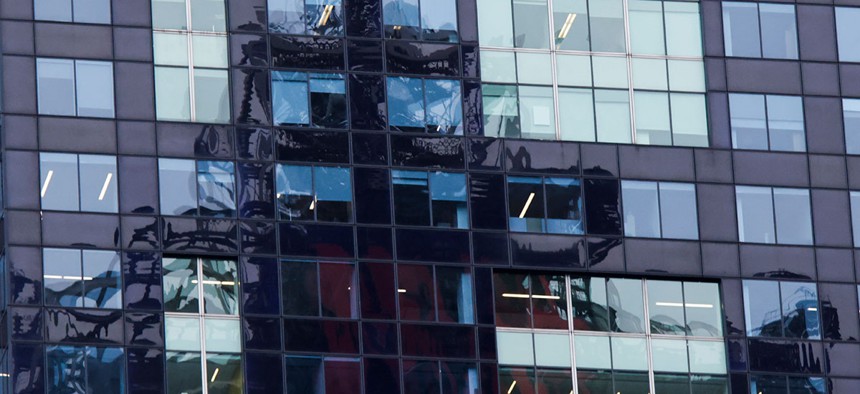New York’s Death Grip on In-office Work is Starting to Loosen

General views of office buildings in midtown Manhattan on October 03, 2022. Kena Betancur/VIEWpress via Getty Images
Amid workforce crises, Eric Adams cracks open the door to “flexible” arrangements and Kathy Hochul invests in a hybrid future.
New York City Mayor Eric Adams has come a long way from ridiculing remote workers for staying at home in their pajamas all day.
Adams has long professed that employees need to be in the office – not only for productivity and “cross-pollinating ideas” – but to revive the city’s business districts that have struggled to recover since the height of the COVID-19 pandemic. But on Tuesday, following reporting by Gothamist that municipal workers’ calls for hybrid work would be considered by the administration in upcoming contract negotiations, Adams expressed a more open stance on allowing some remote work.
“Yeah,” Adams said at an unrelated press conference, when asked whether working from home was on the table as a potential solution for the city’s workforce shortage. “What we are doing is we are sending out a survey to our agencies and we're saying to our agencies, ‘Come up with creative ways of having flexibility.’”
Gov. Kathy Hochul, meanwhile, has already been getting cozier with the notion of a future that might just mean more employees working in their pajamas all day. Despite aligning herself with the philosophy that in-person work is best – “I really do want everyone back in their offices,” Hochul said last February – some state workers are allowed to work remotely.
New York state agencies administer their own policies on teleworking, according to Hochul’s office, and most agencies offer eligible employees the ability to work from home for some portion of the week under those policies.
Private sector reports indicate that any hope for a full-time return to the office is looking grim. Bloomberg News reported that due to at least partly remote schedules, Manhattan workers are spending $12.4 billion less a year on restaurants, retailers and other business district offerings. The Partnership for New York City reported recently that the share of Manhattan office workers showing up in person on an average weekday is growing – up from 38% last April to 52% this January. But the number of people coming into the office five days a week is stagnant. In the spring of 2022, the organization found 8% were coming into the office every day. Last month, it was up to just 9%.
But despite the underwhelming prospects of a full return to the office – or perhaps because of them – New York officials’ death grip on a in-person work is loosening. Hochul appears to be leaning further into a hybrid work future, in fact.
Hochul’s executive budget proposal includes a section on “rebuilding the public sector workforce,” citing a shortage of 12,500 state workers. (Adams’ slow softening on hybrid work comes amid the city’s own workforce shortage. Some city employees have pointed to the rigidity on in-office work as a motivator for quitting.)
Hochul’s executive budget includes an initiative to modernize state office buildings to “facilitate hybrid work schedules, while increasing collaboration and productivity.” Many state agencies have hybrid models in place, Hochul’s office said, and the proposal would fund a pilot to restructure office layouts, optimize space usage and find cost savings in owned and leased space.
Despite most state agencies offering hybrid options, some lawmakers and labor groups have been pushing for more flexibility. The Public Employees Federation represents about 50,000 mostly white collar state employees. Rob Merrill, a spokesperson for the union, said that per their collective bargaining agreement, each state agency had to develop a telecommuting policy for employees. While some roles are unable to telecommute because the nature of their work is in-person, others can work hybrid schedules. But employees still have to apply and be approved to telecommute. “We are looking for more flexibility with regard to telecommuting schedules as sometimes agencies can be very rigid in their implementation of telecommuting programs,” Merrill wrote in an email.
Assembly Member Nily Rozic has also reintroduced a bill that would have agencies develop policies allowing employees to complete all or some of their duties through telework “to the maximum extent possible without diminished employee performance.” Rozic’s office did not immediately return a request for comment about how she wants to see the state’s current approach to hybrid work change.
Back in New York City, Adams is not quite as far along. While some of his recent comments have indicated more openness to hybrid work, it will still likely be a point of much debate in contract talks. On Tuesday, Adams said that he wanted to avoid creating a “two-tier” system that disadvantages municipal workers who can’t work remotely. “What do I do to my school crossing guard, my nurse, my doctor? What do I do for the police officers?” Adams asked. “We want as a team to say, “How do I look out for my fellow civil servant to say you have to come in, so how do we compensate you in some way?’ And that is what we need to do.”





